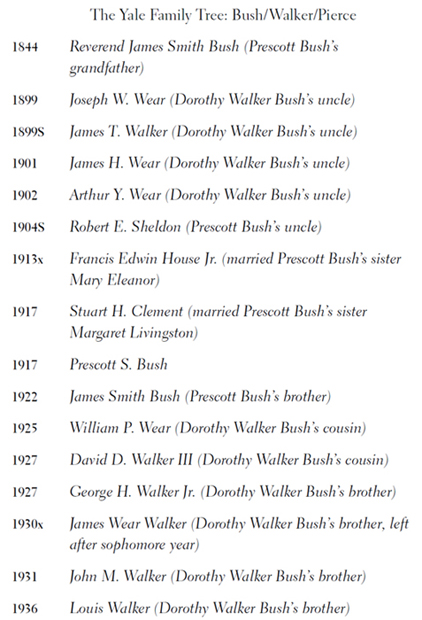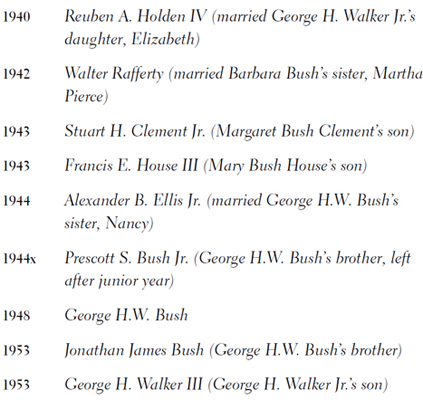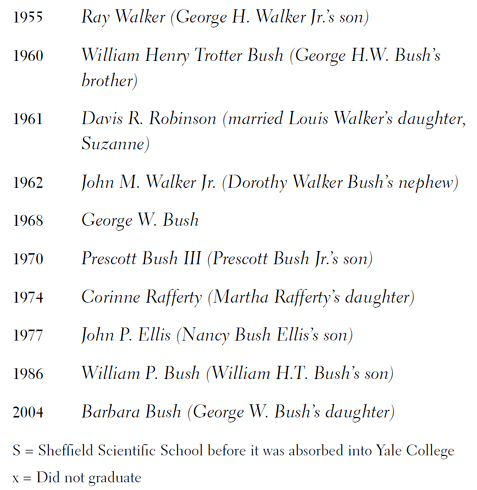The Family (4 page)

“I enjoyed all the advantages of that very much indeed,” Prescott recalled many years later in an oral history, describing the new world he was encountering, “with athletic fields and a beautiful gymnasium and all these things that we didn’t have in the public schools . . . For that reason I think I appreciated it more than some of the boys who came there from private schools.”
“St. George’s was most definitely a rich boy’s school,” said John G. Doll, the school archivist. “We were very select, snobbish, and quite elitist then. Most of the boys were enrolled the day they were born, when their fathers sent telegrams to the headmaster to reserve their space. That all changed after the Depression.
“We had a jacket-and-tie dress code during the time Prescott Bush [1908–13] and his brother, Jim [1914–18], attended, plus a heavy emphasis on religion, with chapel once a day and twice on Sunday. The boys had to walk three miles each way to attend St. Columba’s Church on Sundays. We were a big feeder into Harvard, Yale, and Princeton. Still are. We’re still much smaller and more exclusive than any of the other prep schools like Exeter and Andover, but now, of course, we’re coed.”
Records at St. George’s show Prescott Bush to have been a mammoth presence. “He was really a big man on campus,” said John Doll, rattling off a stupendous record of athletics and extracurriculars, including first-squad (varsity) football, baseball, and basketball. In addition, Prescott was president of Civics Club, vice president of Red and White Council, president of Dramatic Association, leader of the Glee Club, and president of Golf Club. “He was a marvelous actor and played the lead of Sherlock Holmes in the school play,” said Doll. But the biggest honor came his senior year, when he was elected head prefect. In those days, that position, the equivalent of student-body president, carried the perquisite of a private suite of rooms that consisted of a large den with a working fireplace and a small private bedroom. So Prescott must’ve had a very happy senior year indeed.
When Flora and Samuel received advance word that their son had been elected head prefect, they were told to say nothing until the announcement was made at school. Flora could barely contain herself. She wrote to her husband:
I asked Prescott if there had been any elections and he said yes—baseball and he is Captain—he said Buchanan had two votes—but he had the rest. We did not speak of the other honor—the one Mr. Griswold told us of—until just as he left he said, “Mother, I won’t get that.” I did not peep—nor even
look
wise but let it go—as I presume it is better to wait—but naturally I should like to have relieved his mind.
Prescott entered St. George’s after the sweet summer of 1908, and his graduation five years later brought him to the threshold of his life’s most formative experience—Yale, class of 1917.
“For me,” he said years later, “it all began with Yale.” He credited the university with shaping his entire life. Certainly his career would have been different, for he met his future boss Walter Simmons, who hired Prescott for his first job, at a Yale reunion. His personal life would have been far different as well. Because of that job in St. Louis for the Simmons Hardware Company, he met the wealthy Yale family the Walkers and his future wife, Dorothy Walker. After a series of sales jobs, Prescott used his Yale connections to launch his career as an investment banker.
If it’s true that, as one Yale man said, “there will always be two Yales—the Old Blues and the rest of us,” Prescott Bush was an Old Blue. He made no apology to “the rest of us” for his lifelong genuflections to Yale. The school had given him everything he valued most, and he felt no need to look beyond his college ties. As far as he was concerned, he’d met the best, so he ignored the rest.
After graduation, Prescott regularly attended Yale class reunions and Whiffenpoof anniversaries. He visited New Haven and the tomb of Skull and Bones at least once—and sometimes as often as five times—a year. Whenever he could, he sang at the tables down at Mory’s, the clubby Yale restaurant where the Whiffenpoofs assembled to raise their glasses and sing their songs. He was an associate fellow of Calhoun College from 1944 to 1972; a Chubb Fellow in 1958; and an associate of Saybrook College. He served as a Yale trustee. He was the first chairman of Yale’s Development Board. Prescott sat on the Yale Corporation for twelve years, served as secretary of his alumni class, and was a member of the executive council. Figuratively and literally, he never left Yale.
In writing to his class on the eve of his fiftieth reunion, he reflected on the importance of the school in his life: “I am more than ever conscious of what Yale has meant to me since 1913. Wherever I found myself in war or peace, in business or politics, in sports or social life, always the fact of Yale seemed to be there. I make this acknowledgement with a grateful heart.”
Prescott walked onto the New Haven campus as a Yale “legacy” of his paternal grandfather, the Reverend James Smith Bush, class of 1844, and his maternal uncle Robert E. Sheldon Jr., class of 1904. Within four years he would create his own legacy, which would open Yale’s exclusive doors to several more generations of Bushes, including his four sons, his three grandsons, his two nephews, and, in 2001, his great-granddaughter:



When the head prefect of St. George’s arrived for his freshman year of college, he looked like a matinee idol. At six feet four, he was the second-tallest man in his class, and one of the handsomest. His hair was as dark as sealskin and parted down the middle to show what Grandmother Harriet Bush called his “noble forehead.” He was a good student and majored in history, but he truly excelled in sports, particularly as a first baseman on Yale’s baseball team. So important were sports in the lives of Yale men then that “Not Winning a ‘Y’” was listed as one of the “Biggest Regrets of College” by the class of 1917. Prescott had won his baseball letter by his junior year. He went out for the golf team and even became a football cheerleader, all of which combined to make him one of the most admired men on campus.
“There was a sort of mystique in the old days of people who were good in sports,” said Stuart Symington Jr. (Yale 1950), son of the late senator from Missouri. “My father was a superior athlete. So was Pres Bush. They were the lords of creation . . . In that era, excellence in sports was highly prized. You’d see banner headlines in
The New York Times
that Yale beat Harvard or Princeton. It mattered greatly then. In that country-club world—small, social, and cohesive—a sport played well was a gauge of competence, a badge of manhood.”
In his history of the school, Brooks Mather Kelley described Yale’s class of 1917 as “more interested in their games, newspapers, sports and societies than . . . the curriculum.” That could have been written to describe Samuel Bush’s son. Socializing was a big part of college life for Prescott, who volunteered for Interfraternity Council, Junior Prom Committee, and Class Day Committee. “To Have Made Friends” was listed by the class of 1917 as the “Most Valuable Thing Obtained from College.”
Prescott began scaling Yale his first week on campus. Singing was a cherished college tradition, so he immediately joined the Yale Glee Club, the Yale Quartet, and the Yale Men’s Choir. In his senior year he was selected second bass for the Whiffenpoofs. “Life is but one song,” he told the
Yale Daily News
. By then, he had become known as the hottest close-harmony man Yale had seen in twenty-five years.
“Prescott loved music,” said Richard D. Barrett (Yale 1953). “He was made of music. That was the core of his character—his love of singing. He was happiest when he was singing . . . and he had a wonderful booming voice, a marvelous bass that he loved using. After he left Yale, he formed a group, all Yalies, of course, called the Silver Dollar Quartet that sang for years. When they died, Prescott found us and formed another group called the Kensington Four. He craved singing and was never without song.”
In a 1957 letter Prescott sent to Yale about the Silver Dollar Quartet, he said the group had been performing for thirty-five years:
We began in 1922. For many years we made pilgrimages to Mory’s to sing with the Whiffenpoofs. In the thirties we formed the Yale Glee Club Associates and planned and conducted its meetings in New York until I resigned as president, thinking a change of leadership would be helpful.
We introduced many a song at Yale. They still sing many of our songs even if they have changed arrangements and tempi in some to conform with their more modern tastes.
Despite interruptions such as World War II when General Spofford [Charles M. Spofford, 1924] joined Eisenhower’s staff and later went to preside over NATO . . . for most of each year we still carry on at every opportunity.
Prescott reveled in group activities. He pledged Psi Upsilon fraternity and joined the College Christian Association as well as the Young Men’s Christian Association of Dwight Hall. He fit easily with the 347 students of his freshman class, most of whom were white Anglo-Saxon Protestant preppies. A profile of that class emerges from their answers to a questionnaire.
The fathers of 149 students had graduated from a university, and 58 of those had graduated from Yale. More than half of the fathers had not graduated from any college. Prescott’s father had graduated from Stevens Institute of Technology with a degree in engineering, so that placed Prescott in the educated minority of his class. The class of 1917 listed football as their favorite sport, Douglas Fairbanks as their favorite actor, and Maude Adams as their favorite actress. Alfred, Lord Tennyson was their favorite poet, and “Crossing the Bar” their favorite poem. Their favorite writer was Charles Dickens, their favorite novel
Lorna Doone
, and they said English was the most valuable subject. The person they admired most in history was Abraham Lincoln, which may account for the 227 students who listed themselves as Republicans.
The twenty-two Catholics, fifteen Methodists, ten Jews, nine Baptists, and one Buddhist in the class defined its religious diversity. Racially, there was no diversity; the entire class was Caucasian. A majority of the students said they used tobacco and alcohol, and 113 had traveled abroad by the time they arrived at Yale, but Prescott was not one of them.
When the class wrote its history shortly before graduation, they voted on those who had “Done Most for Yale” in their four years there: Harry William LeGore won with 129 votes; Prescott S. Bush placed second with 36 votes. “Most Popular” was Spencer Armstrong Pumpelly, with 174 votes; Prescott S. Bush placed fifth with 21 votes. “Most to Be Admired” was Spencer Armstrong Pumpelly, 108 votes; fourth was Prescott Bush, 30 votes. Prescott was not mentioned in the categories of “Best Natured,” “Best All-Around Athlete,” “Most Scholarly,” “Most Brilliant,” or “Most Likely to Succeed,” but he did win “Most Versatile,” with 70 votes.
“There’s a difference, a big difference,” said Stuart Symington Jr., “between going to Yale and scaling Yale. The hierarchy of Prescott Bush’s Yale began with excelling in sports. With that achievement you could qualify for the next step—a fraternity, then an honor society—all a staging area for the senior societies, the final step up the ladder. The senior societies held the greatest prestige, and of them nothing mattered more than Skull and Bones. Scaling that world of Yale was more important than getting the college education or degree of Yale.”
